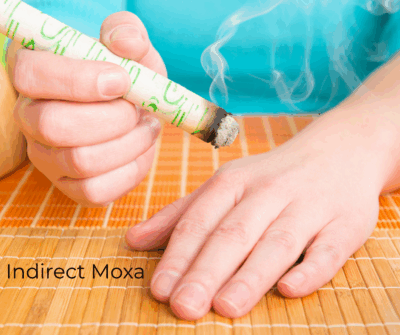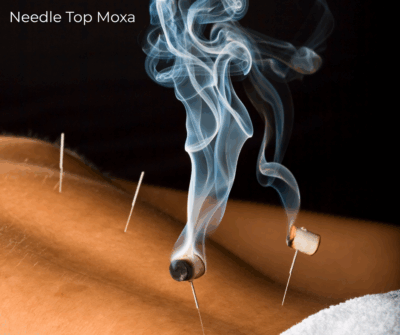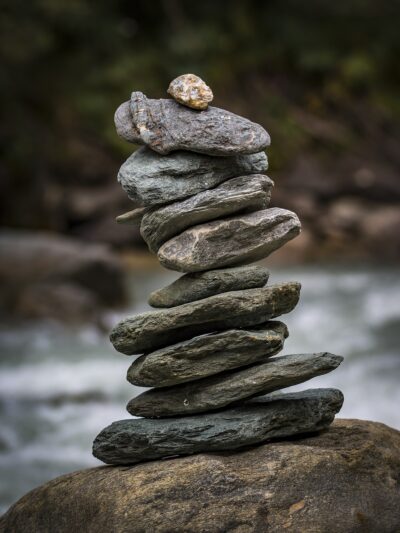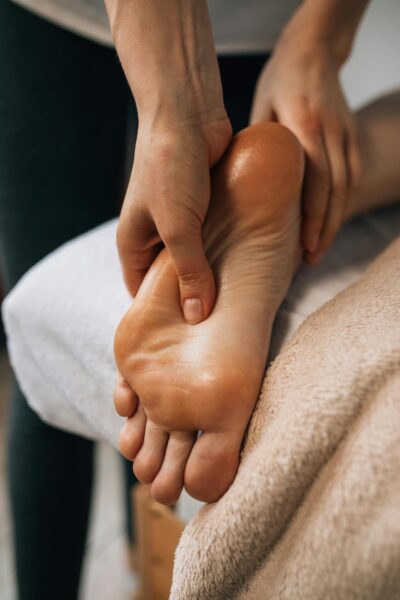Ever noticed a warm, earthy scent in an acupuncture clinic? That gentle, smoky aroma is likely from moxa, short for moxibustion—a time-tested therapy in Traditional Chinese Medicine (TCM). Moxa involves the careful burning of dried mugwort on or near acupuncture points to promote healing and warmth throughout the body.
What Is Moxa?
Moxa is made from the mugwort plant (Artemisia vulgaris), a type of chrysanthemum that has been used for centuries to support immunity, circulation, and overall wellness. The dried leaves are processed into a fluffy, wool-like material and used in various ways during acupuncture sessions.
When burned, moxa delivers a soothing heat therapy that improves the flow of Qi (energy) and blood, which are essential for maintaining balance and health in the body.

How Is Moxa Used?
Moxa can be applied in several forms during a session. Here are the most common types of moxibustion used in our clinic:
- Stick-on Moxa: Small cones with a protective base that are placed on the skin and lit. These provide localized warmth without burning.
- Rice Grain Moxa: Tiny pieces of moxa about the size of a grain of rice are applied directly to acupuncture points for targeted stimulation.
- Pole Moxa: A large stick that looks like incense. It’s lit and held a few inches from the skin, warming the area without touching it.
- Moxa Boxes: These boxes hold loose moxa and are placed over larger areas like the abdomen to distribute gentle heat more broadly.

Why Use Moxibustion?
In TCM, cold, stagnation, or Qi deficiency can lead to symptoms like pain, fatigue, and digestive issues. Moxa acts like a mini “sunshine” session for the body—it melts away energetic blockages and encourages natural healing.
Think of your body like Boulder Creek in winter. When it’s frozen over, water (or energy) can’t flow freely. But as the weather warms in spring, the ice melts and the creek flows again. Moxa works the same way to restore your natural rhythm and energy flow.
Who Can Benefit from Moxa?
Moxa is a safe, non-invasive therapy used for a wide range of conditions. Common uses include:
- Warming the Body: Especially helpful for people with cold hands and feet, feeling chilly year-round, or experiencing fatigue.
- Pain Relief: Used for arthritis, menstrual cramps, and injuries by promoting circulation and reducing stagnation.
- Boosting Energy and Immunity: Great for fatigue, chronic illness, or frequent colds.
- Women’s Health and Fertility: Supports menstrual regularity, eases period pain, and is commonly included in fertility treatments.
- Turning Breech Babies: Research shows moxa applied to the acupuncture point BL-67 (near the pinky toe) can help babies move into the right position before birth.
👉 See the study on moxa for breech babies - Improving Digestion: Relieves bloating, diarrhea, and loose stools by warming the digestive system.
Is Moxibustion Right for You?
If you’re curious about natural ways to support your health, moxa may be a gentle but powerful option. Whether you’re managing pain, balancing hormones, supporting digestion, or boosting your energy, this traditional therapy can be a valuable part of your wellness routine.
References
1. Chen, R., & Wang, Y. (1998). [Clinical study on moxibustion treatment]. PubMed.
https://pubmed.ncbi.nlm.nih.gov/9820259
2. Cleveland Clinic. (2022). Moxibustion: What It Is, Benefits, and Risks.
https://health.clevelandclinic.org/moxibustion
3. Virginia University of Integrative Medicine. (2023). Moxibustion in
Acupuncture: History, Uses, Benefits & Cautions.
https://www.vuim.edu/post/moxibustion-in-acupuncture-history-uses-benefits-
cautions
Written by Barb Jones, Edited by Erin Pass



